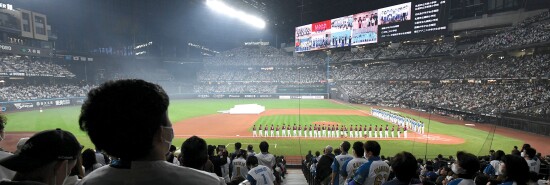
Japanese baseball, model to the world
Michael M. Rosen
If you combine the berserk energy of a college basketball arena, the traditional pomp and circumstance of a royal parade, the unbridled passion of a European soccer cup final, and the studied intensity of a championship chess match, you might begin to approach a facsimile of one of the world’s great sporting experiences: watching a Japanese baseball game.
Japanese baseball formally began in 1934, when Dai Nippon Tokyo Yakyu Kurabu, a predecessor to Yomiuri, battled a touring American all-star team populated by the likes of Babe Ruth, Lou Gehrig, and Jimmie Foxx. By midcentury, Nippon Professional Baseball had organized itself into two leagues comprising four teams each. Currently, 12 teams span the two leagues, including two in Tokyo alone: the Giants and the Yakult Swallows.
A HISTORY OF THE FRENCH RIVIERA
The Japanese absorbed this foreign game and made it thoroughly their own. Baseball quickly became, and still remains, the most popular team sport in Japan, including among young people, with a network of little leagues, high school teams, and minor leagues bristling with talent.
Japan has also exported an astounding array of highly skilled ballplayers to MLB, the first of which was Hideo Nomo, who electrified the Los Angeles Dodgers upon his arrival in 1995. Their ranks grew to include Ichiro Suzuki, one of the game’s best-ever leadoff hitters; Hideki Matsui, the 2009 World Series MVP for the Yankees; and Shohei Ohtani, the otherworldly Los Angeles Angels superstar who has excelled both at bat and on the mound.
In the United States, an injection of foreign talent has helped improve the game’s popularity, which has dipped in recent decades, at least relative to football and basketball. And MLB recently implemented several key modifications to its regulations in an attempt to accelerate the game and increase scoring, including implementing a pitch clock, enlarging the size of the bases, and prohibiting defensive shifts.
During a recent visit to Tokyo, I was fortunate to take in a professional match. And I’m pleased to report that in Japan, where tradition and innovation coexist, professional baseball is thriving, without any of the kind of desperate rule changes that MLB imposed earlier this season to goose the game’s flagging popularity stateside.
We arrived at the Tokyo Dome one sweltering August evening during the first inning of a game between the league-leading Hanshin Tigers and the host Yomiuri Giants. Figuring we’d settle in nicely among supporters of the Giants, with 22 Nippon Series championships, easily the sport’s winningest team and, as such, the Yankees of the league, we had come prepared with the home team’s jerseys and hats.
So imagine our surprise to find our section, and the surrounding sections, occupying fully half of the stadium, swathed not in Yomiuri orange but clad in the distinctive black and yellow of Hanshin (thank you, StubHub). Like Homer Simpson in the notorious hedge GIF, we quietly slipped our Giants merch back into our handbags and transformed ourselves into Tigers fans.
The Tigers supporters’ cheering was riotous and extremely well organized: Fans demonstrated an easy familiarity with an endless series of chants, some lauding individual batters, others official and unofficial team anthems. And as Hanshin jumped out to a quick lead, which by the third inning had ballooned into a 5-0 advantage, the team’s “ultras” erupted in celebration: drums, a bugle, and inflatable bat-shaped thunder sticks produced a deafening (and highly entertaining) roar. Imagine Game Seven of the NBA Finals, only louder and more joyous.
In a cover story this summer that attracted a great deal of attention, The Atlantic’s Mark Leibovich detailed “How Baseball Saved Itself,” noting how desperately “baseball needs to attract new fans.” Leibovich surveyed league professionals, players, and scribes in an effort to understand why children no longer gravitate toward the national pastime and whether the rule changes could revive interest. Noting that the game’s speed has picked up remarkably in just half a season, he observed how MLB was “introduc[ing] a novel ethic into its stationary culture: urgency.”
But across the Pacific, Japanese baseball needs no such introduction. NPB teams and fans reflect the country’s famously seamless merger of tradition and innovation, of commitment to their teams and its customs and creative ways of expressing it.
This combination of history and novelty emerged in spades that night in August, especially as the Giants stormed back to narrow the Tigers’ lead to 5-4 by the bottom of the sixth on the strength of home runs by Hisayoshi Chono and Kazuma Okamoto. While not as boisterous as the Hanshin fans, Yomiuri’s supporters finally began to roar back, growling chants and displaying elaborate hand motions of their own.
CLICK HERE TO READ MORE FROM THE WASHINGTON EXAMINER
As tension built in the stadium, backers of Hanshin, which led Yomiuri in the standings by more than 10 games, continued their cheers, albeit more anxiously. And as their team pulled ahead, insurmountably, as it turned out, with two more runs in the top of the eighth, their jubilance returned.
By the end of the game, my wife, initially a reluctant spectator, found herself fully absorbed in the action, befriending our Tigers fan neighbors in the stands, joining in their raucous cheers, and even learning a few. What MLB and I had been unable to accomplish over the course of 23 years of marriage, Japanese baseball had achieved in just two short hours. Whatever the Japanese are doing in baseball, it’s clearly working.
Michael M. Rosen is an attorney and writer in Israel and a nonresident senior fellow at the American Enterprise Institute.
